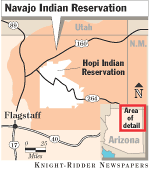 |
 |
 |
| Your account | Today's news index | Weather | Traffic | Movies | Restaurants | Today's events | ||||||||
|
December 4, 1996
Largest tribe has greatest need
Tso-Yazzie determines which Navajo families most need government-subsidized housing. Recently, she inspected the home of a family of 11 in the reservation's western region. George and Anna Betoney live with four children and five grandchildren. Tso-Yazzie described their home: "It was built out of old railroad ties and half-inch sheets of roofing paper and scrap lumber. It's about 16 feet by 16 feet. The roof was coming off. There was a big hole. You could see daylight coming through. It had a dirt floor. Five people lived there. "The other six lived in a little shade house attached to the main house. The roof was made of tarps. The walls were made of shower curtains and cardboard. Half of it was exposed. They might as well have been outside. The wood stove they used to cook food was outside. "There was an outhouse. No phone, no electricity, no running water. All the water they had was stored in a 50-gallon barrel. They live about six miles from a house where they pump water. "I was saddened by the whole thing." Yet thousands of families on the reservation live in similar conditions. The nation's largest tribe also has the largest needs. More than 20,000 Navajo families are in urgent need of homes, according to tribal officials. Of the 30,000 existing homes, 82 percent lack either running water, indoor plumbing, electricity or central heating. Nearly 80 percent don't have telephones. Navajo President Albert Hale recently told a congressional subcommittee that the problem "could be characterized as a crisis." The Navajo reservation is 17.5 million acres of sparsely populated desert spanning Arizona, New Mexico and Utah. The reservation is slightly larger than West Virginia, and is home to three-fourths of the 200,000 enrolled members. They are among the poorest of America's rural poor, with an unemployment rate of up to 50 percent, and a per-capita income of $4,100. The majority live in the outlying areas of the reservation, which is not near major population centers. This is the main reason the tribe has no plans to build a casino, said Ken Peterson, a Navajo official in charge of infrastructure and housing. A 1994 referendum to build a casino failed when 55 percent voted against it. Tribe members didn't believe gaming was financially viable in their isolated desert location and didn't feel it would have any direct impact on them. The most destitute section of the reservation is known as the "Bennett Freeze" area, named after Robert Bennett, a former Bureau of Indian Affairs commissioner. The area, encompassing 2 million acres in the western segment, had been the subject of a decades-old boundary dispute between the Navajo and the neighboring Hopi Tribe. Because of litigation, housing officials imposed a construction freeze that lasted more than 20 years. Some 15,000 people live there, many in conditions similar to those of the Betoneys, with patchwork homes constructed with scavenged materials.
A federal court recently awarded most of the land to the
Navajos, and now the tribe is trying to "unfreeze" the area. Only
last month, Navajo President Hale sent a letter to President Clinton
requesting $24 million for infrastructure and housing for the region.
|
|
|||||||||||||||||||||||||||||||||||||||
seattletimes.com home
Home delivery
| Contact us
| Search archive
| Site map
| Low-graphic
NWclassifieds
| NWsource
| Advertising info
| The Seattle Times Company
